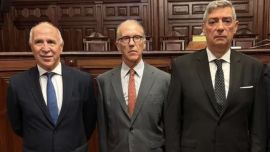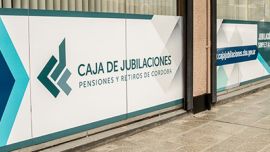For the first time in this series concluding next Saturday, we will be looking at a province which does not exist, strictly speaking: Buenos Aires (which not only does exist, of course, but is widely considered as the key to the upcoming elections). What we will be analysing today has 111, not 135 districts – it is missing Greater Buenos Aires, which will be the grand finale of this series next week.
Even without GBA, today’s province remains comfortably the largest and most populous in Argentina – with a population of 5,677,913, according to the 2010 census. While GBA is basically urban sprawl with the odd green patch or wasteland, the province beyond is not just rural and agricultural pampa (apart from a few hilly areas like Tandil) – there are at least four important concentrations of population.
These are the provincial capital of La Plata, the main Atlantic resort of Mar del Plata, the Delta area immediately north of Greater Buenos Aires and the port of Bahía Blanca. Greater La Plata has some 900,000 people including its two main satellites, the port of Ensenada and Berisso, with its oil refinery, Mar del Plata would not be far behind and Greater Bahía Blanca has over 360,000 people. Rather than any one city comparable to the above trio, the Delta north of Tigre is a densely populated area with over a million people stretched across eight departments. Yet even adding up these four concentrations, they account for around 47 percent of the population beyond Greater Buenos Aires – over half is scattered around an area the size of Italy, although only 3.6 percent is purely rural.
The big picture in Buenos Aires Province is obviously whether Governor María Eugenia Vidal and her UCR-Radical Lieutenant-Governor Daniel Salvador can secure re-election against the strong challenge of former economy minister Axel Kicillof and La Matanza Mayor Verónica Magario heading a list which now has the Renewal Front’s Sergio Massa (the provincial kingmaker over the last decade) on board. Yet this is neither the time nor the place to discuss this clash – not the time because so much can change in the almost four months still to go and not the place because almost two-thirds of the votes deciding the election are going to come from Greater Buenos Aires, not the province as defined today. For what it is worth, this hinterland leans towards Vidal – and even more given the main opposition. As Interior Minister Rogelio Frigerio observed in an interview recently published in this newspaper, if the presidential candidacy of Alberto Fernández represents an attempt to open up, the Kicillof-Magario ticket slams doors – and all the more so in rural areas with its image of voracious state intervention and urban sprawl. Which does not make Vidal invulnerable even here, especially in Mar del Plata but also in the other two main City Halls (La Plata and Bahía Blanca) now in her hands.
In the last general elections in 2015 Cambiemos won 60 of the 111 districts in the province as defined today, including the five largest cities (Greater Buenos Aires reduces their edge to 69-66 in the province as a whole). Starting with the provincial capital, incumbent La Plata PRO Mayor Julio Garro should 'win' next month’s PASO comfortably since Frente de Todos fragments into five lists (the ultra-Kirchnerite Florencia Saintout, Victoria Tolosa Paz closer to Alberto Fernández, Guillermo Escudero linked to the Greater Buenos Aires mayors, pro-picket and pro-immigrant Luis Arias and neighbourhood Catholic activist Federico Martelli). Even Roberto Lavagna’s Federal Consensus 2030 has three hopefuls. Garro’s re-election might well hinge on the Peronist winner’s ability to pool rival votes.
Far less likely is any re-election in Mar del Plata, where the deeply unpopular mayor bounced from Cambiemos, Carlos Arroyo, has formed his own list (as has 2007-2015 ex-mayor Gustavo Pulti). In Arroyo’s stead Vidal has imposed heavyweight deputy Guillermo Montenegro (former judge, City Security minister and ambassador to Uruguay), who is resisted by local politician Vilma Baragiola. The PASO mayoral primary will also be contested within Frente de Todos between deputy Fernanda Raverta and Horacio Tettamanti. The dozen hopefuls also include three leftists and two Lavagna backers. In Bahía Blanca, meanwhile, Frente de Todos feel that they cannot afford the luxury of disunity if they are to oust incumbent Mayor Héctor Gay (Cambiemos but with a non-Kirchnerite Peronist background). Tandil Radical Mayor Miguel Angel Lunghi’s bid for a fifth term will be resisted internally by Marcos Nicolini while Frente de Todos has a single candidate. In Necochea-Quequén Cambiemos Mayor Facundo López won one of the closest races of 2015. Of the 111 mayors excluding Greater Buenos Aires, a total of 101 are seeking re-election.
Turning to Congress, we will devote minimal space to the three senators for at least two reasons – they are not up for renewal until the next general elections in 2023 and they received saturation coverage in the 2017 midterms when they were the almost exclusive centre of attention. On that occasion former two-term president Cristina Fernández de Kirchner was famously defeated by a relative lightweight Esteban Bullrich (education minister until his candidacy) and a newcomer Gladys González who displaced former foreign minister Jorge Taiana – Fernández de Kirchner entered the Upper House as the minority senator and has recently become perhaps the first vice-presidential candidate to be nominated by herself rather than by the top of the ticket. No more here on the Senate, either this week or next.
The accompanying graphic shows the 35 deputies who will be keeping their seats until the next midterms in 2021 while the other half whose seats are up this October will accompany next week’s Greater Buenos Aires column. It might be noted here though that Buenos Aires province is grossly underrepresented, because its 70 deputies give it just 27 percent of the 257-seat Lower House when it has almost 40 percent of the national electorate (the inevitable consequence of a five-seat floor for even the least populated provinces).
Underrepresented numerically, the province nevertheless seems overrepresented in quality – of the 35 deputies listed here, little more than a dozen have made much of a name for themselves. Graciela Ocaña has worked in three parties (Health Minister for Kirchnerism, Elisa Carrió’s Civic Coalition and now PRO) but always against corruption, thus earning her the top spot for Cambiemos in the 2017 midterms. Apart from Montenegro, only Héctor “Toty” Flores (born in a shantytown as the seventh son of an alcoholic father) stands out in the government benches as a solitary Cambiemos voice from the picket world.
Among the opposition, two-term provincial governor Daniel Scioli was 2015 presidential runner-up but only fifth on the 2017 Kirchnerite list, Fernando Espinoza was mayor of La Matanza (with more voters than all but seven provinces) for a decade, Leopoldo Moreau was the 2003 Radical presidential candidate, Hugo Yasky has long been a leading teacher unionist and economist Fernanda Vallejos was the obscure choice to top the 2017 list. Felipe Solá, Carlos Menem’s Agriculture secretary, governed the province from 2001 to 2007, Daniel Arroyo is an expert in social issues, Argentine Industrial Union (UIA) ex-president and former production minister José Ignacio de Mendiguren champions manufacturers and Mirta Tundis specialises in pensions. Finally, Nicolás del Caño and Romina del Plá make up this year’s Workers’ Leftist Front (FIT) presidential ticket.
Buenos Aires has far more history as a city than as a province and there is not too much in the hinterland under study today which predates the foundation of La Plata as the provincial capital in 1882. Earlier settlements such as Dolores, Tandil, Bahía Blanca and Azul founded between 1817 and 1832 were fortresses rather than towns and of these only Bahía Blanca escaped destruction by Mapuche “malón” raids – this was Indian territory for most of the 19th century. This province is so central to Argentina that as from 1882 provincial and national history are mostly intertwined.
Similar difficulties with the governors. Colonial governors ruled the city rather than the province while between independence and Dardo Rocha (1881-1884) the Buenos Aires governor often ruled as much of the rest of Argentina as permitted by provincial strongmen – in particular, Juan Manuel de Rosas (1829-52) was an unelected president (or “tyrant anointed by God,” as he preferred to call himself) but also others to a lesser extent like Martín Rodriguez. Between Rocha (the first provincial governor in the modern sense) and Vidal, there have been 41 governors and 48 trustees. Only in 1962 (Andrés Framini) and 1999 (Carlos Ruckauf, both Peronists) has the elected governor not overlapped with the national government of the day – the province chose conservatives like Marcelino Ugarte in the predemocratic period, Radicals like José Camilo Crotto between 1916 and 1930, masters of fraud like Manuel Fresco in the “infamous decade,” Domingo Mercante during the first Peronist government (1946-1955) and 28 years of Peronist rule between Antonio Cafiero (1987-1991) and Scioli (2007-2015). No Buenos Aires governor has ever been elected president although Eduardo Duhalde was a 2002-2003 caretaker.
Apart from the main centres of population listed above, Tandil
and Necochea-Quequén also have six-digit populations. Other
important regional centres are Pergamino, the cement town of
Olavarría, Junín, Luján with its basilica, Mercedes, Chivilocoy
(the fifth city of the republic according to the 1914 census) and
Azul. No room for tourist tips beyond the Atlantic coast centred
on Mar del Plata with its beaches and chalets (founded in 1873),
the hills of Tandil and Balcarce breaking the pampa monotony,
the gaucho traditions preserved around San Antonio de Areco,
Tres Arroyos for its Dutch and Danish colonies – though this is a
list which is far from exhaustive.related news





















Comments